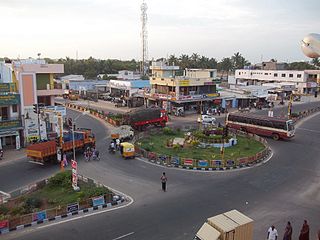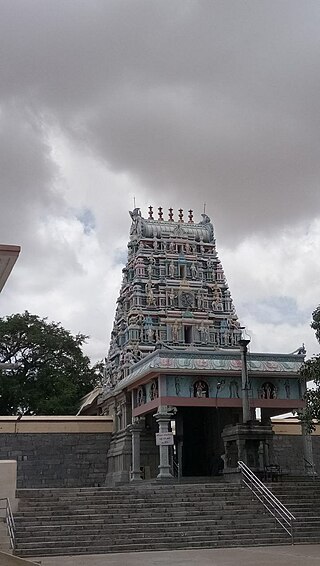
Namakkal is a city and the headquarters of Namakkal district, Tamil Nadu. It is the first ISO 14001-2004 certified municipality in Asia for environmental management, specifically the provision and maintenance of water supply, solid waste and sewage management, town planning, lighting and other social services. Namakkal is known as the Egg City due to its large egg production and Transport city.

Thindukkalalso spelt, Dindigul, is a city in the Indian state of Tamil Nadu. It is the administrative headquarters of the Dindigul district. Dindigul is located 420 km (260 mi) southwest from the state capital, Chennai, 100 km (62 mi) away from Tiruchirappalli, 105 km (65 mi) away from Karaikudi, 66 km (41 mi) away from Madurai and 72 km away from the Tex City of Karur. The city is known for its locks and biryani. Parts of Dindigul Districts like Palani, Oddanchatram, Vedasandur, Nilakottai, Kodaikanal, Natham, Athoor.

Temple cars or Temple chariots are used to carry representations of Hindu gods around the streets of the temple on festival days. These chariots are generally manually pulled by the devotees of the deity.

Dindigul District is one of the 38 districts in the state of Tamil Nadu in India. Dindigul District is the largest district in Tamil Nadu by area. The district was carved out of Madurai District in 1985. It has an area of 6266.64 km2 and comprises 3 revenue divisions, 10 taluks, and 14 panchayat unions. The district is located in Southwest of Tamil Nadu. The district is bound by Madurai district in the south,Tiruppur district in the northwest, Karur district in the north, Tiruchirappalli district in the northeast, Theni district in the Southwest and Idukki district of Kerala to the west. As of 2011, the district had a population of 2,159,775 with a sex-ratio of 998 females for every 1,000 males.
Tiruchengode is a selection grade municipality located in western part of southern Indian state of Tamil Nadu. It is famous for the ancient hilltop Ardhanareeswarar Temple, dedicated to the unique combined male-female form of Lord Shiva and Goddess Parvathi. This important place of pilgrimage is mentioned in the Tamil work Silapathikaram as 'Nedulkundru' and is celebrated in the hymns of Saivite saints. The equally famous Chenkottu Velavar Temple, dedicated to Lord Murugan, is situated on the same hill. As of 2011, the town had a population of 95,335. As per 2011 population, Tiruchengode is the largest city in Namakkal district. It is also famous for rig business.
Sankarankovil is a Town in the Tenkasi district in the Indian state of Tamil Nadu. It was formerly known as Sankaranayinarkoil. Sankarankovil is the home to the Sankara Narayanar Temple.

Aravakurichi is a panchayat town and a Taluk headquarters in Karur district in the state of Tamil Nadu, India. Aravakurichi is well known in Tamil Nadu as a major market for Moringa oleifera vegetable. Aravakurichi is the headquarters of Aravakurichi taluk which consists of 40 revenue Villages.

Batlagundu is a town in Nilakottai block in Dindigul district in the Madurai Region state of Tamil Nadu, India. The name Vetrilaikkundru later transformed and changed to Vathalagundu. The town is the major gateway to Kodaikanal. Subramaniya Siva was a writer, Indian Freedom Fighter, and activist born in Batlagundu. Batlagundu is the fifth-largest town in the Dindigul district. The town is located in such a way connecting three main districts of South Tamil Nadu. Batlagundu has most of the voters in Nilakottai Constituency.

Dharapuram is a town situated along the banks of Amaravati River in Tiruppur district in the Indian state of Tamil Nadu. Dharapuram is one of the oldest towns in South India and was the capital of Kongu Nadu under the Cheras, Western Ganga Dynasty and later Kongu Cholas, at which time it was known as Viradapuram. Amaravathi River flows through the town. As of 2011, the town had a population of 67,007. The city houses famous temples including Agatheeswarar Temple, Kaadu Hanumanthasamy temple and many others.

Oddanchatram is a town in Dindigul district in the Indian state of Tamil Nadu. Oddanchatram is a region in the southwest of Tamil Nadu. The Town was carved out of Madurai District in 1985. Oddanchatram is also famous for vegetable and cattle market. As of 2011, the town had a population of 30,064. It is known as vegetable city of Tamil Nadu. Oddanchatram vegetable market is the largest supplying of vegetables in Tamilnadu and Kerala. Agriculture is the major economic support for the town.

Kangeyam is a historical town and municipality in Kangeyam Taluk of Tiruppur district in the Indian state of Tamil Nadu. It is situated on National Highway 81. Kangeyam is an economic center in Tamil Nadu. The main commercial interests of the municipality are rice hulling, coconut oil extraction, ghee production, and groundnut cultivation. The town is located 28 km from the district headquarters at Tiruppur, 45 km from the city of Erode, 70 km from the industrial town of Coimbatore,30 km from the town of Dharapuram, 55 km from the city of Karur, 140 km from the Ancient city of Trichy and 441 km from the state capital Chennai.
Madathukulam is Border to Dindigul District in Tirupur district in the Indian state of Tamil Nadu.

Arulmigu Dhandayuthapani Swamy Temple is third of the Six Abodes of Murugan. It is located in the city of Palani, Dindigul district, 100 kilometres (62 mi) southeast of Coimbatore and northwest of Madurai in the foothills of the Palani Hills, Tamil Nadu, India. Known as Thiruaavinankudi in the old Sangam literature of Thirumurugatrupadai, Palani temple is considered synonymous with Panchamritam, a sweet mixture made of five ingredients.
Andipatti taluk is a taluk of Theni district of the Indian state of Tamil Nadu. The headquarters of the taluk is the town of Andipatti.

Palani Railway Station is an NSG–4 category Indian railway station in Madurai railway division of Southern Railway zone. It is a single-electric lined train station serving Tamil Nadu's pilgrim town of Palani situated in the western part of the state. The station is a part of the Madurai railway division of the Southern Railway zone and falls on the Pollachi–Dindigul section.

Uthiyur is a small town in Kangeyam taluk of Tiruppur district in south Indian state of Tamil Nadu.

Kundadam is a small town located in Dharapuram taluk of Tiruppur district in Indian state of Tamil Nadu. It is the headquarters of the Kundadam Panchayat Union in Tiruppur district. It is located 16Km away from Dharapuram in Coimbatore-Dharapuram highway. In the classical Tamil texts, this town is named as Kundrai, Kundrapuram, Kundrai Managar and Kundridam. The town houses famous temples including Varatharājaperumāl Temple, Kala Bairavar Temple, Kongu Vatuganādha Swāmy Temple, Koṅgar Chinnamman Temple and Vadivudaimangai Udanurai Konguvidangkisuvarar Temple.
Thoppampatti is a small town located in Palani taluk of Dindigul district in Indian state of Tamil Nadu. It is the headquarters of the Thoppampatti Panchayat Union in Tiruppur district. It is located 20 kilometers away from Dharapuram and 10 kilometers away from Palani in Erode-Dharapuram-Palani highway.
Kartikeya temple is a type of Hindu temple where the main deity is Lord Kartikeya, one of the sons of prime Hindu deities Lord Shiva and Goddess Parvati. Such temples are usually found in the southern part of India and the south eastern Asian countries. There are six abodes of Lord Murugan all of which are in Tamil Nadu state of India.




















